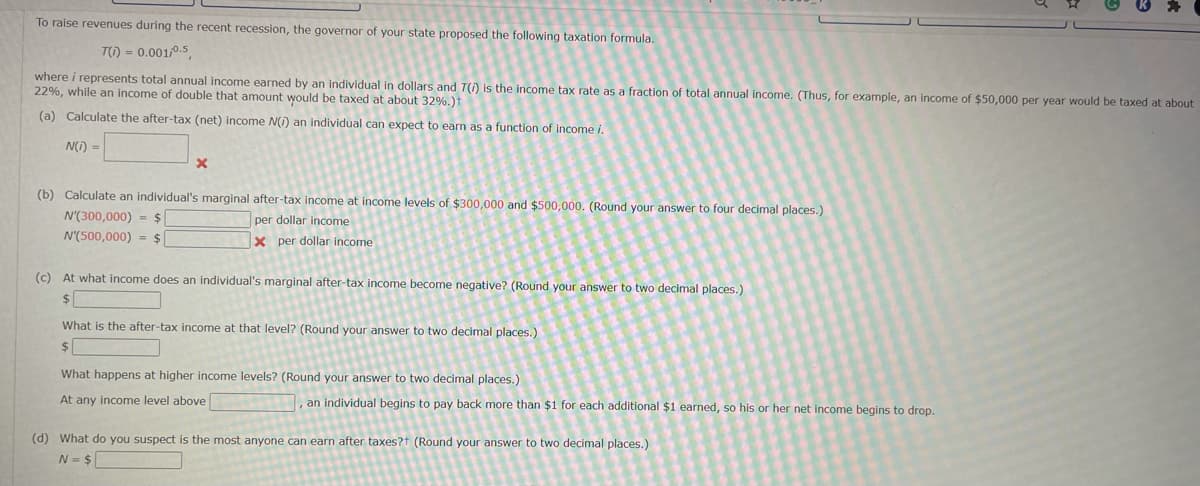To raise revenues during the recent recession, the governor of your state proposed the following taxation formula. T() = 0.0010.5, where i represents total annual income earned by an individual in dollars and T(i) is the income tax rate as a fraction of total annual income. (Thus, for example, an income of $50,000 per year would be taxed at about 22%, while an income of double that amount would be taxed at about 32%.)t (a) Calculate the after-tax (net) income N(i) an individual can expect to earn as a function of income i. N(i) = (b) Calculate an individual's marginal after-tax income at income levels of $300,000 and $500,000. (Round your answer to four decimal places.) N'(300,000) = $ per dollar income N'(500,000) = $ x per dollar income (c) At what income does an individual's marginal after-tax income become negative? (Round your answer to two decimal places.) 2$ What is the after-tax income at that level? (Round your answer to two decimal places.) $ What happens at higher income levels? (Round your answer to two decimal places.) At any income level above , an individual begins to pay back more than $1 for each additional $1 earned, so his or her net income begins to drop. (d) What do you suspect is the most anyone can earn after taxes?t (Round your answer to two decimal places.) N = $
To raise revenues during the recent recession, the governor of your state proposed the following taxation formula. T() = 0.0010.5, where i represents total annual income earned by an individual in dollars and T(i) is the income tax rate as a fraction of total annual income. (Thus, for example, an income of $50,000 per year would be taxed at about 22%, while an income of double that amount would be taxed at about 32%.)t (a) Calculate the after-tax (net) income N(i) an individual can expect to earn as a function of income i. N(i) = (b) Calculate an individual's marginal after-tax income at income levels of $300,000 and $500,000. (Round your answer to four decimal places.) N'(300,000) = $ per dollar income N'(500,000) = $ x per dollar income (c) At what income does an individual's marginal after-tax income become negative? (Round your answer to two decimal places.) 2$ What is the after-tax income at that level? (Round your answer to two decimal places.) $ What happens at higher income levels? (Round your answer to two decimal places.) At any income level above , an individual begins to pay back more than $1 for each additional $1 earned, so his or her net income begins to drop. (d) What do you suspect is the most anyone can earn after taxes?t (Round your answer to two decimal places.) N = $
Chapter12: The Partial Equilibrium Competitive Model
Section: Chapter Questions
Problem 12.10P
Related questions
Question

Transcribed Image Text:To raise revenues during the recent recession, the governor of your state proposed the following taxation formula.
T() = 0.001/0.5,
where i represents total annual income earned by an individual in dollars and T(i) is the income tax rate as a fraction of total annual income. (Thus, for example, an income of $50,000 per year would be taxed at about
22%, while an income of double that amount would be taxed at about 32%.)t
(a) Calculate the after-tax (net) income N(i) an individual can expect to earn as a function of income i.
N(i) =
(b) Calculate an individual's marginal after-tax income at income levels of $300,000 and $500,000. (Round your answer to four decimal places.)
N'(300,000) = $
per dollar income
N'(500,000) = $
X per dollar income
(c) At what income does an individual's marginal after-tax income become negative? (Round your answer to two decimal places.)
$
What is the after-tax income at that level? (Round your answer to two decimal places.)
$4
What happens at higher income levels? (Round your answer to two decimal places.)
At any income level above
, an individual begins to pay back more than $1 for each additional $1 earned, so his or her net income begins to drop.
(d) What do you suspect is the most anyone can earn after taxes?t (Round your answer to two decimal places.)
N = $
Expert Solution
This question has been solved!
Explore an expertly crafted, step-by-step solution for a thorough understanding of key concepts.
This is a popular solution!
Trending now
This is a popular solution!
Step by step
Solved in 5 steps with 3 images

Recommended textbooks for you






